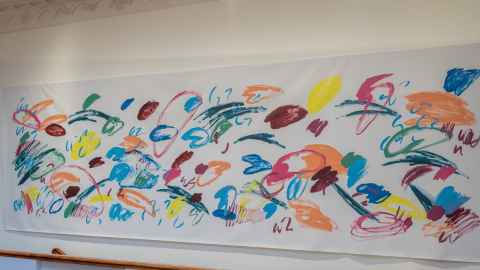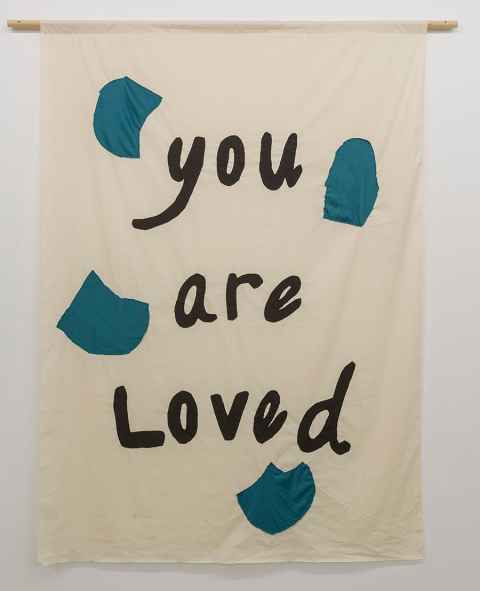Salome Tanuvasa's art another highlight in University's collection
2 October 2023
The University of Auckland art collection comprises around 1,700 items. Art collection adviser Madeleine Gifford showcases a piece by Salome Tanuvasa.

Salome Tanuvasa’s multi-media arts practice has been described as based on an intuitive technique “akin to automatic writing”, informed by the space around her, in turn creating a space for what she is feeling.
Sinuous lines and peculiar shapes dance across the many surfaces of her artworks, five of which are held in the University of Auckland Art Collection.
Depending on the medium, her works are often rapidly executed in paint, pastel and pencil; or, are more slowly brought to life in fabric. Salome’s practice brings together a striking colour palette and an intuitive method, resulting in an eclectic oeuvre in which each artwork responds to the environment in which it was created.
Salome is based in Tāmaki Makaurau Auckland and is of Tongan and Sāmoan heritage. Born in 1987, she is a graduate of the Elam School of Fine Arts, holding a Master of Fine Arts which was followed by a Diploma in Secondary Teaching.
She has been exhibiting since 2012, a notable exhibition being Stars Start Falling curated by Hanahiva Rose at Govett-Brewster Art Gallery (2021). The show linked Pacific artists of different generations and brought Salome’s works into conversation with paintings by Teuane Tibbo (the first Pacific artist to hold an exhibition at a New Zealand dealer gallery, in 1964) and weavings by Ani O’Neill, who rose to prominence in the 1990s and is part of the Pacific Sisters Collective.
Salome’s practice centres around her immediate surroundings and often reflects the space she is in at that particular time. As well as her artistic work, Salome is a mother and a full-time teacher. This means her dedicated studio time is fleeting, as reflected in her 2018 exhibition titled, In a Midnight Hour (Tim Melville Gallery). The works in this exhibition, like many in her oeuvre, were created from the dining room table at home in the depths of night, when the house was quiet and Salome had the space to work in what she calls her ‘state of flow’.
The artist’s mark-making is intuitive and inspired by that which she observes in nature and her immediate surroundings.

In a text from Salome’s 2022 solo exhibition at Page Galleries, this intuitive technique is described as “a process akin to automatic writing – where words are produced subconsciously – the artist’s mark-making is intuitive and inspired by that which she observes in nature and her immediate surroundings. Tanuvasa’s forms begin to take on a visual code or language, or rather she creates space for a particular feeling or sensation to emerge”.
This is exemplified in Untitled (2021), a monumental acrylic on unstretched canvas painting, first commissioned for the exhibition From Our Beautiful Square at Gus Fisher Gallery (2021) and now part of the University Art Collection. Measuring two metres by seven, the painting is frieze-like, with Salome’s gestural markings stretching across the canvas. The marks not only respond to the architecture and ‘place’ of the gallery (it was created in situ), but also document Salome’s own movements, almost like drawn markers of time and place.
Four of Salome’s textile banners are also part of the collection. Three are titled by the single word cut from calico that centres their composition; Beauty (2019), Essence (2019) and Informal (2019). The fourth, Reflections I (2018) is around three times the size, with the words ‘you are loved’ as the subject. In contrast to her drawings, the shapes and words are slowly hand-stitched in these calico works, sparking a contemplation of their meaning and deeper musings around the artist’s intention of their focus.
It is rare to witness an artist at work, and when engaging with Salome’s practice I’m reminded of when I once had the opportunity to see her process in action. She incorporated a large-scale artwork directly onto the 12m wall at the Tim Melville Gallery as part of solo exhibition Mirrored Systems.
Making an artwork for a wall is not dissimilar to having an enormous blank canvas to work on, and I wondered how Salome could not feel intimidated. Would she make a preliminary sketch and then transfer it to the wall? Where would her first mark go? To my surprise, and without saying anything, she picked up a humble charcoal pencil from her selection of paint test-pots and marker pens, before walking straight up to the wall and confidently making her first (rapid) form. Blink and you would have missed it.
I left her alone to work and returned the next day to find an expansive wall-drawing that marked her presence in the space, embodying her focus and the utmost resolve in her method.
Madeleine Gifford, Art Collection adviser
This article first appeared in the October 2023 UniNews.